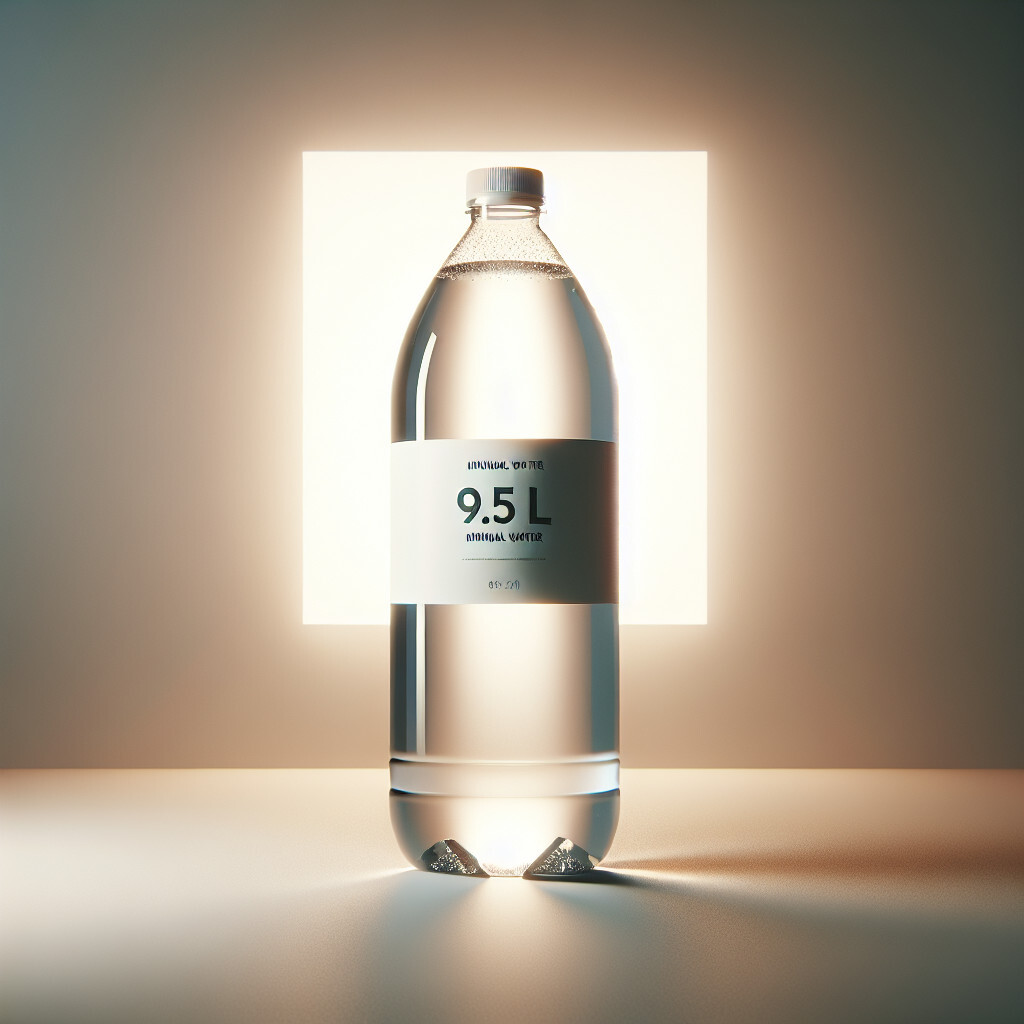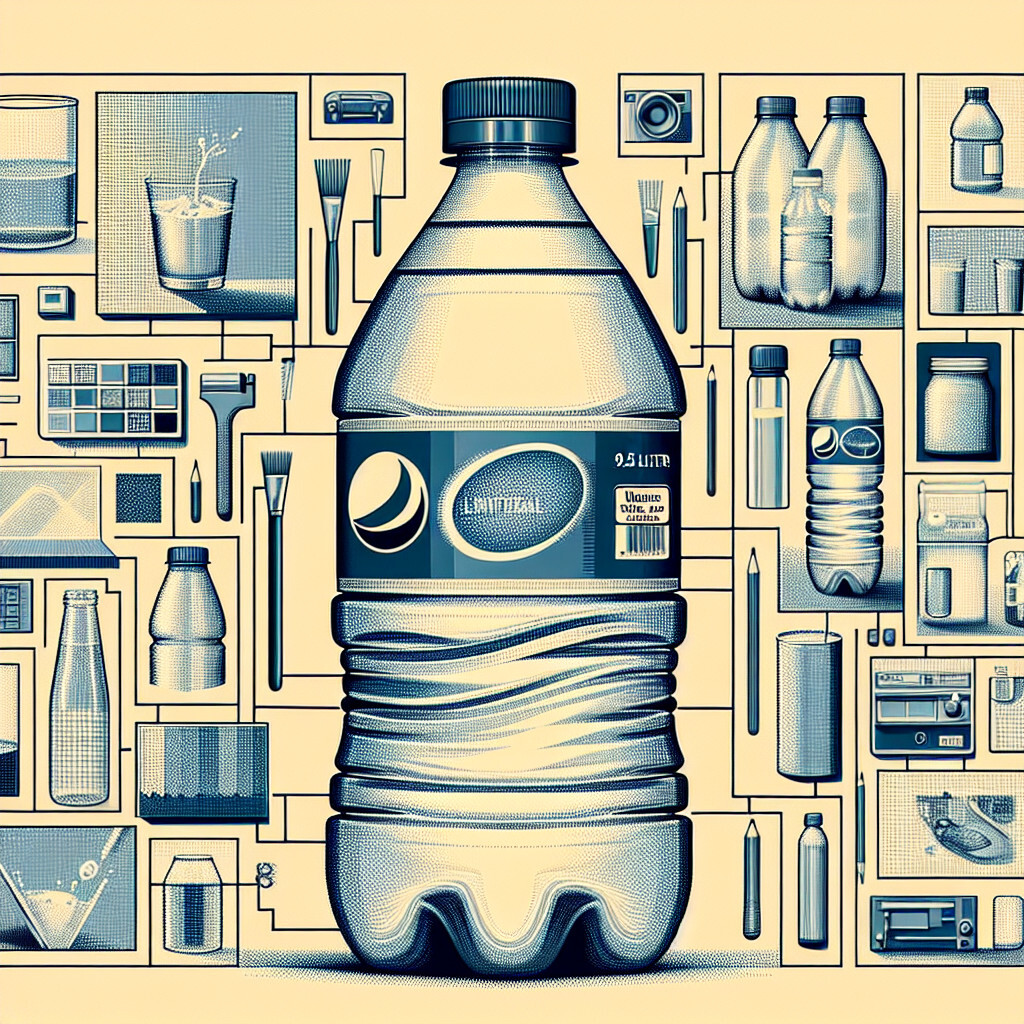-
Table of Contents
“Quench Your Thirst, Fuel Your Health: 9.5 Liter Mineral Water”
Introduction

Mineral water 9.5 liter refers to a large quantity of water that has been fortified with various minerals such as magnesium, calcium, and potassium. This type of water is often sourced from natural springs or wells, and undergoes minimal processing to maintain its mineral content. The 9.5 liter size is ideal for households or workplaces, ensuring a steady supply of hydrating, mineral-rich water. The pH level of 9.5 indicates that the water is alkaline, which some believe can help neutralize acid in the body and promote overall health.
Understanding the Health Benefits of 9.5 Liter Mineral Water
Mineral water, specifically the 9.5-liter variant, has been gaining popularity in recent years due to its numerous health benefits. This type of water is not just a thirst quencher but also a source of essential minerals that the body needs for optimal functioning. The 9.5-liter size is particularly convenient for households, offices, and fitness centers, ensuring that there is always a sufficient supply of this healthful beverage.
Mineral water is water from a mineral spring that contains various minerals, such as salts and sulfur compounds. The mineral content of this water can vary widely, depending on the source. However, it typically includes minerals like calcium, magnesium, and potassium, which are vital for human health. The 9.5-liter variant of mineral water provides a substantial quantity of these minerals, making it an excellent choice for those looking to enhance their mineral intake.
One of the primary health benefits of 9.5-liter mineral water is its contribution to bone health. The calcium found in mineral water is crucial for the development and maintenance of strong bones and teeth. Regular consumption of mineral water can help prevent conditions like osteoporosis and other bone-related ailments. Moreover, the magnesium in mineral water aids in the absorption and metabolism of calcium, further enhancing its bone-strengthening effects.
Additionally, the potassium content in mineral water plays a significant role in maintaining heart health. Potassium helps regulate heart rhythm and blood pressure, reducing the risk of heart disease. It also aids in muscle function and nerve transmission, contributing to overall bodily function.
Mineral water is also beneficial for digestion. The sulfate compounds present in it can stimulate the production of digestive enzymes in the liver, aiding in the digestion process. Furthermore, the magnesium in mineral water can help alleviate constipation by softening the stool and promoting intestinal motility.
The 9.5-liter mineral water is not only beneficial for internal health but also for external health, particularly the skin. The silica particles in mineral water can strengthen the spongy cells in between collagen and elastin fibers, slowing down wrinkle formation and improving skin elasticity. Regular consumption of mineral water can thus contribute to a youthful and radiant complexion.
Despite these numerous health benefits, it is essential to note that mineral water should not replace regular water intake. While it is a good source of minerals, it should complement a balanced diet rich in fruits, vegetables, lean proteins, and whole grains. Overconsumption of mineral water can lead to an excess intake of certain minerals, which can have adverse health effects.
In conclusion, the 9.5-liter mineral water offers a plethora of health benefits, from promoting bone and heart health to aiding digestion and improving skin quality. Its large size makes it a convenient option for those who wish to incorporate mineral water into their daily routine. However, like any other dietary supplement, it should be consumed in moderation and as part of a balanced diet. With these considerations in mind, the 9.5-liter mineral water can be a valuable addition to a healthy lifestyle.
The Environmental Impact of 9.5 Liter Mineral Water Packaging
Mineral water, a staple in many households, is often consumed for its perceived health benefits and refreshing taste. However, the environmental impact of its packaging, particularly the 9.5-liter bottles, is a topic that warrants attention. This article aims to shed light on the environmental implications of the production, use, and disposal of 9.5-liter mineral water packaging.
To begin with, the production process of these large plastic bottles is energy-intensive and contributes significantly to carbon emissions. The raw material for these bottles, polyethylene terephthalate (PET), is derived from crude oil and natural gas. The extraction and refining of these fossil fuels, coupled with the manufacturing process of the bottles, result in substantial greenhouse gas emissions. Furthermore, the transportation of these heavy 9.5-liter bottles from factories to retail outlets and then to homes also adds to the carbon footprint.
In addition to the carbon emissions, the production of 9.5-liter mineral water bottles also leads to water pollution. During the manufacturing process, harmful chemicals are often released into water bodies, causing damage to aquatic life and ecosystems. Moreover, the extraction of mineral water itself can lead to the depletion of natural water resources, particularly in regions where water scarcity is already a pressing issue.
Moving on to the usage phase, the environmental impact of 9.5-liter mineral water bottles continues to be significant. While these large bottles may seem to be a more sustainable choice compared to smaller ones due to the reduced plastic-to-water ratio, this is not necessarily the case. The reason being, these bottles, due to their size and weight, are often not fully consumed before the water goes stale, leading to wastage of both water and the packaging material.
The final stage in the life cycle of a 9.5-liter mineral water bottle is its disposal. Despite being recyclable, a large proportion of these bottles end up in landfills or oceans due to inadequate recycling infrastructure and lack of consumer awareness. In these environments, they take hundreds of years to decompose, releasing toxic chemicals into the soil and water in the process. Furthermore, when these bottles are incinerated, they emit harmful gases that contribute to air pollution and climate change.
In conclusion, the environmental impact of 9.5-liter mineral water packaging is multifaceted, encompassing carbon emissions, water pollution, resource depletion, and waste generation. While the convenience and perceived health benefits of mineral water may make it an attractive choice for consumers, it is crucial to consider the environmental implications of this choice.
To mitigate the environmental impact, consumers can opt for alternatives such as tap water or filtered water, which have a lower environmental footprint. Additionally, efforts should be made to improve recycling infrastructure and raise consumer awareness about the importance of proper disposal. On the industry side, manufacturers can explore more sustainable packaging options and strive to make their production processes more energy-efficient. By taking these steps, we can enjoy the benefits of mineral water while minimizing its impact on our planet.
Comparative Analysis: 9.5 Liter Mineral Water Brands
Mineral water, a vital component of our daily hydration needs, is often overlooked in terms of its quality and source. However, with the increasing awareness about health and wellness, consumers are now more discerning about the type of water they consume. Among the various options available in the market, mineral water with a 9.5-liter capacity has gained significant popularity. This article aims to provide a comparative analysis of different brands offering 9.5-liter mineral water, to help consumers make an informed choice.
Firstly, let’s consider the brand Evian. Originating from the French Alps, Evian is renowned for its naturally occurring electrolytes and minerals. The 9.5-liter offering is packaged in a recyclable plastic jug, ensuring a lower environmental impact. However, Evian’s price point is on the higher end of the spectrum, which may not be suitable for all consumers.
On the other hand, we have the brand Fiji. Known for its soft, smooth taste, Fiji’s mineral water is sourced from an underground aquifer in the remote Yaqara Valley of Viti Levu. The 9.5-liter packaging is designed for easy storage and handling. While Fiji’s price point is more affordable than Evian, it’s important to note that the mineral content in Fiji water is slightly lower.
Next in line is the brand Essentia. Essentia’s 9.5-liter mineral water is unique due to its ionization process, which removes acidic ions, resulting in a higher pH level. This makes Essentia an excellent choice for those seeking alkaline water. The brand also prides itself on its rigorous testing for purity and quality. However, the plastic packaging of Essentia’s 9.5-liter offering is not as environmentally friendly as some of its competitors.
Lastly, let’s look at the brand Voss. Sourced from an artesian well in Norway, Voss offers mineral water with a clean, crisp taste. The 9.5-liter packaging is in a glass bottle, which is not only aesthetically pleasing but also more sustainable than plastic. However, Voss’s price point is relatively high, and the glass packaging, while environmentally friendly, may not be as convenient for some consumers.
In conclusion, when choosing a 9.5-liter mineral water brand, consumers should consider several factors. These include the source and mineral content of the water, the environmental impact of the packaging, and the price point. While Evian and Voss offer high-quality water with sustainable packaging, their higher price points may not be suitable for all consumers. On the other hand, Fiji and Essentia offer more affordable options, but with slightly lower mineral content and less environmentally friendly packaging. Ultimately, the choice depends on the individual consumer’s preferences and priorities.
The Process of Producing 9.5 Liter Mineral Water
Mineral water, a vital component of our daily lives, is not just a thirst quencher but also a source of essential minerals for our body. The process of producing 9.5 liter mineral water is a meticulous one, ensuring that the water is not only safe for consumption but also enriched with necessary minerals.
The journey of mineral water begins at the source, typically a spring or a well. The water from these sources is naturally filtered through layers of rocks, which imbue it with a variety of minerals such as calcium, magnesium, and potassium. The water is then collected in a controlled environment to prevent any contamination.
Following the collection, the water undergoes a rigorous purification process. This process involves multiple stages of filtration to remove any impurities or harmful substances that might have been present in the water. The first stage is usually a coarse filtration to remove larger particles. This is followed by a fine filtration process that removes smaller impurities.
After the filtration process, the water is subjected to a disinfection process. This is a crucial step in ensuring the safety of the water. The most common method of disinfection is the use of ultraviolet (UV) light. UV light effectively kills or inactivates harmful microorganisms, ensuring that the water is free from any disease-causing bacteria or viruses.
Once the water is disinfected, it is time to add the minerals back into the water. This is done in a controlled manner to ensure that the mineral content is consistent in every bottle. The minerals are added in a specific proportion to maintain the taste and health benefits of the water.
The final step in the process is bottling the water. The 9.5 liter bottles are thoroughly cleaned and sterilized before the water is filled. The filling process is automated to ensure precision and avoid any human contact with the water. Once filled, the bottles are sealed immediately to maintain the purity of the water.
Quality control is an integral part of the entire process. At every stage, samples are taken and tested to ensure that the water meets the required standards. Any deviation from the set standards is immediately addressed to ensure that the final product is of the highest quality.
The process of producing 9.5 liter mineral water is a testament to the commitment to providing safe and healthy water. It is a meticulous process that ensures that every drop of water in the bottle is not just pure but also enriched with essential minerals.
In conclusion, the production of 9.5 liter mineral water is a complex process that involves careful collection, rigorous purification, precise mineral addition, and stringent quality control. The end result is a bottle of water that is not just a thirst quencher, but a source of essential minerals for our body. So, the next time you reach for a bottle of mineral water, remember the meticulous process that ensures its purity and quality.
Q&A
Question 1: What are the benefits of drinking 9.5 liter mineral water?
Answer: Drinking 9.5 liter mineral water is not recommended as it exceeds the daily recommended water intake. Overconsumption of water can lead to water intoxication.
Question 2: How much does a 9.5 liter bottle of mineral water typically weigh?
Answer: A 9.5 liter bottle of mineral water typically weighs approximately 9.5 kilograms, not including the weight of the bottle itself.
Question 3: Is there a difference in the mineral content between a 9.5 liter bottle of mineral water and smaller bottles?
Answer: No, the mineral content is determined by the source of the water, not the size of the bottle. Therefore, a 9.5 liter bottle of mineral water should have the same mineral content as smaller bottles from the same source.
Question 4: How long can a 9.5 liter bottle of mineral water be stored?
Answer: Unopened, a 9.5 liter bottle of mineral water can be stored for about two years. Once opened, it should be consumed within a few days to maintain its freshness and prevent bacterial growth.
Conclusion
In conclusion, a 9.5 liter mineral water can provide a substantial amount of hydration, essential minerals and electrolytes. It is a convenient size for households or for individuals who consume a large amount of water. However, it may be heavy and difficult to carry for some people. It’s also important to store it properly to maintain its freshness and quality.






